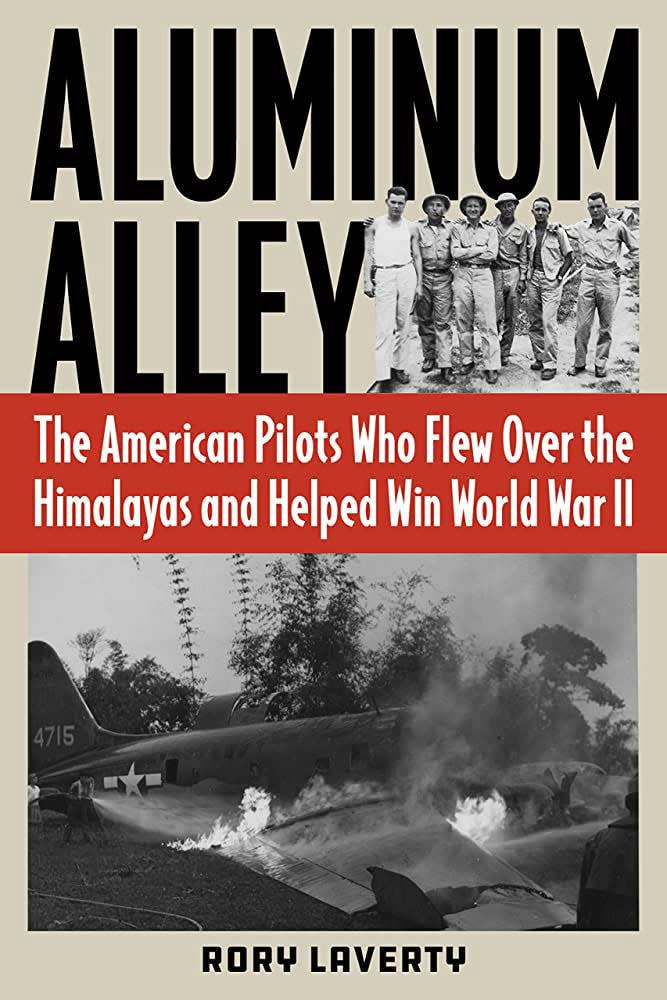New book from UNCW professor recounts the brave WWII pilots who flew down 'Aluminum Alley'

- Oops!Something went wrong.Please try again later.
- Oops!Something went wrong.Please try again later.
- Oops!Something went wrong.Please try again later.
In the 1940s, boys of all ages scanned their newspaper's comic pages for "Terry and the Pirates," Milt Caniff's adventure strip about American pilots and soldiers of fortune aiding Chinese Resistance fighters against the Japanese invaders.
These days, however, few people remember that America even had a combat role in China in World War II. Rory Laverty, a freelance writer who also teaches English and journalism at the University of North Carolina Wilmington, sets out to remind us.
Laverty's new book, "Aluminum Alley: The American Pilots Who Flew Over the Himalayas and Helped Fight World War II," recalls the days when American transport pilots regularly flew over the Himalayas, the highest mountains in the world, to ferry supplies from India to China after the Japanese cut off the Burma Road.
It was dangerous work. The pilots transported everything from troops to mules, but their main cargo was high-octane aviation fuel to keep American aviator Claire Chennault's "Flying Tigers," and later the U.S. 14th Air Force, flying.
This turned the planes into flying bombs. Air crews shivered because the only available heaters ran on open-flame propane.
Their craft were primarily C-47s, nicknamed the "Goony Bird," and C-46s, "the Dumbos," after Disney's improbable flying elephant. The C-47s needed near-constant maintenance. The engines on the C-46s had a bad habit of freezing at high altitudes. Occasionally, wings flew off.
The casualty rate among these "non-combatant" pilots rivaled that of U.S. bomber groups in Europe. Roughly a third never came home. Remains from their plane crashes were being discovered as late as the 1970s.

Did it make a difference? Laverty argues yes. By keeping Chiang Kai-shek's Nationalist forces in the field, Americans of the China-Burma-India (CBI) theater tied up 1.5 million Japanese soldiers. Fighting the Chinese and the 14th Air Force drained precious fuel from the Imperial Japanese air force and navy, leaving them less able to fight in the Pacific.
Some of the tacticians who planned and ran this "over the hump" supply line would later make the Berlin airlift work in 1949.
Laverty tells his story on two fronts. For the big picture, we're introduced to a colorful cast of characters including Chiang, whom Laverty rates as corrupt but cunning, using Confucian strategy to play a weak hand masterfully.
The Chinese leader's wife, the Wellesley-educated Madame Chiang, actually ran Nationalist air policy for a while. Charming and even seductive, she and her brother, the diplomat-lobbyist T.V. Soong, were adept at urging millions in aid from reluctant Americans. (Laverty doesn't mention it, but Madame Chiang and Soong were both children of Chinese businessman Charles Jones "Charlie" Soong, who came to Wilmington as a boy, was baptized at what is now Fifth Avenue Methodist Church and was educated with Methodist help at what is now Duke University.)
More: Wilmington history An opera based on the life of an enslaved Wilmington man has won a Pulitzer Prize
Other historical figures include the mercurial Chennault; his nominal boss, the salty Gen. Joseph "Vinegar Joe" Stilwell; the bombing genius Curtis LeMay; and FDR himself, who vainly dreamed of bombing Tokyo from air bases in China.
For a close-up view, Laverty mainly focuses on Lt. Mel Hodell, a transport pilot who'd grown up as a fan of Charles A. Lindbergh. Hodell, a journalism major from Northwestern University, helpfully left journals and letters.
Laverty is skilled at the art of creative non-fiction, writing history so that it reads like a novel.
Unfortunately, he falls afoul of the decline in book editing. Laverty's publisher, the venerable Stackpole Books, has earned respect over the years for its military histories, but a dismaying number of errors creep into the text.
"Aluminum Alley" says that Lindbergh made his solo trans-Atlantic flight in 1929. (It was 1927). We're told that Japanese sank three U.S. battleships at Pearl Harbor. (It was four battleships, plus one retired battleship intended for target practice.) William "Bull" Halsey is identified as a U.S. Army general, but Laverty puts the admiral back in the Navy in a later chapter.
That, sadly, is just a sample, but they are minor flaws in an otherwise compelling narrative.
Book review
'ALUMINUM ALLEY: The American Pilots Who Flew Over the Himalayas and Helped Fight World War II'
By Rory Laverty
Stackpole Books, $29.95
This article originally appeared on Wilmington StarNews: 'Aluminum Alley' by UNCW professor Rory Laverty tells of WWII pilots

